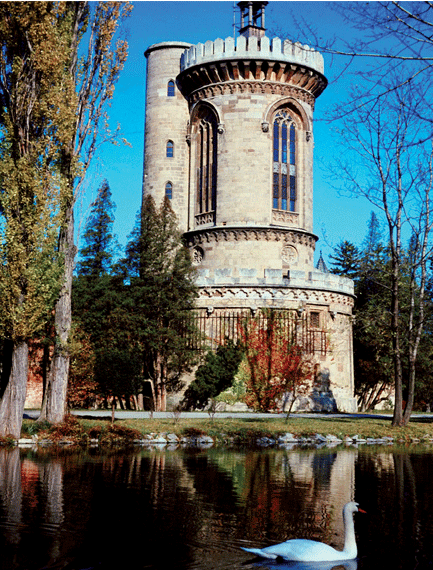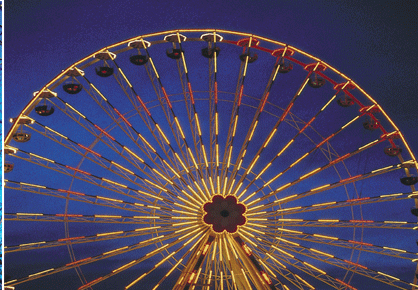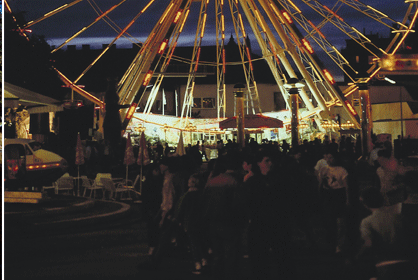Vienna
 Journey to a World of Enjoyment
Journey to a World of Enjoyment
The enchanting Austrian capital is known for its luxurious cafés and restaurants, as well as its charming ambiance
A captivating landscape, a rich symphony, and an enchanting unique work of art embellish Vienna, the Austrian capital. Who has not dreamed one day of the nights of companionship in Vienna, the land of Mozart, where nature adorns a beautiful green garb, and the archaeological sights, palaces, and museums radiate culture and art, and where musical masterpieces enrapture the heart?
A jouPage 10-13rney to Vienna is a journey to a world of enjoyment and nights of companionship, where the clamor of easy shopping and the moments that are lived are not forgotten. Discover comfort in the city of stately cafés, restaurants, hotels and palaces.
Feel rested and healthy. Designate a time for yourself, for your life. The best places for that are Vienna’s spas and the oases of health care that provide care, beauty, activity and treatment. And they are found everywhere, in five-star hotels to country houses, suiting all budgets and requirements.
Health resorts are all over Vienna. The appropriate blend of excellent medical supervision, private physical fitness shows, and compatible nutrition in a comfortable and cordial atmosphere are all factors that have led to giving Vienna’s health resorts the special character for which they have become famous.
There are many hotels in Vienna that provide distinguished service. Are you looking for the meaning of good hospitality? Then try staying at Hotel Imperial. Are you searching for spacious rooms like the halls of imaginary castles? Try Hotel Sacher. Are you looking for elegant indoor swimming pools and luxurious restaurants that offer the most appetizing dishes? Try the Grand Hotel or the Palais Hotel Coburg.
Vienna is famous for its classic cafés. In one that bears his name, Beethoven composed his sweetest symphony. Asmahan also has her share in Vienna, where you will find the walls of one of the cafés adorned with pictures of the singer of “Layálá al-Uns fí Vienna.”
The cafés of Vienna have been attracting tourists for hundreds of years. Legend has it that credit for the discovery of coffee in Vienna goes to the Turks, who besieged the city in a campaign of conquests in 1683. They carried with them coffee beans, the bitter taste of which the inhabitants of Vienna did not find pleasant. They added honey and sometimes milk or cream to the coffee beans, creating new varieties of coffee, which are still being served until today.
In the 19th century, coffee houses began to spread and became popular among the common people. Earlier, coffee was restricted to members of the upper class. What distinguishes the city’s coffee houses is the fact that they do not serve foreign coffee, cakes or sweets. They are all local products. All the coffee shops serve a cup of pure water with each cup of coffee. The Viennese are proud of their pure water, which comes from the mountains.
Do not forget to visit the famous Café Landtmann, which is famous for its variety of coffee and pastries with chocolate cream or fruits. You must visit Demel in the old city, which was formerly the confectioner at the royal court. For 200 years, Demel has been devising cream and sweets. You can even see the bakers at work through the glass panel.
If you are a confectionary lover, you must visit Sacher Eck which offers the popular Sachertorte made from chocolate. It was created by the master confectioner Frantz Sacher in 1832.
“Love passes through the stomach,” is an old saying in Vienna where food is varied – from international cuisine, such as Asian and Mediterranean, to specially prepared meals. Enjoy having real European food in Vienna’s old cafés. Taste the appetizing pot pies or chocolate cake. Try the traditional apple tart, which consists of small pieces of apple wrapped in a thin layer of dough and sprinkled with sugar. It is still kneaded by hand in family cafés.
In order to understand the variety of Austrian cuisine, one must look at the geography of Austria and its historical background. Being situated in the center of Europe, Austria has always been a melting pot of different cultural influences. Each group that arrived in the country and resided in it brought its own ways of cooking. The kitchen of the imperial throne continually designed new recipes for all parts of the country. Middleclass families spread these recipes throughout Europe, while each of the nine provinces made their own special contribution to the internationally famous Austrian dishes. Among these is, of course, the famous dish, wiener schnitzel, in addition to tafilschitz made from veal.
 Those who like to have appetizing fish dishes go to Azzurro, Novelli and Fabios, restaurants famed even beyond the borders of Austria. You can also enjoy fresh fish at Nordsee Gourmet.
Those who like to have appetizing fish dishes go to Azzurro, Novelli and Fabios, restaurants famed even beyond the borders of Austria. You can also enjoy fresh fish at Nordsee Gourmet.
Shopping enthusiasts can spend hours at Vienna’s luxurious shops, offering a wide choice, from luxurious chandeliers and precious jewelry to elegant clothing and branded bags. The Golden U, formed by KSrntner Strasse, Graben, and Kohlmarkt, is a popular city store offering famous brands. In the side streets you find smaller stores also offering a wide selection but with little known brand names.
Mariahilfer Strasse is Vienna’s prime shopping street. Located between the royal palace, or the Hofburg, and the West Banhof Station, the street is lined with hundreds of modern stores along the sidewalks. The stores have a wide variety on sale ranging from jewelry to fashionable garments.
From January to early March, the 4,000-square-meter municipal building (Rathausplatz) square is turned into an ice skating rink. Tourists who have a passion for skating can spend their evenings at the square from 9-11 pm and glide on the ice to the tune of music of the ’80s and ’90s.
The Danube Island Festival is held on the Danube Island for three days at the end of June every year. The festival attracts around three million visitors and over 1,000 artists each year.
Vienna’s Children’s Museum offers an insight into the lives of the Kaiser’s children. Children can get the opportunity to wear the attire of princes and princess.
The Schoenbrun Zoo is for animal lovers. It has the Elephant Park, the Koala House, the Lion House and the Mexican House. Popular displays include coral, lizards and a panda pair from China. Animals and plants from Borneo are exhibited at the rain forests section.
Schoenbrun Palace, the former summer headquarters of the Kaiser’s family, is considered to be one of the most beautiful baroque palaces in Europe. The Hapsburg family used to spend most of the days in its magnificent apartments next to the ceremonial rooms. The Schoenbrun Palace is on the UNESCO World Heritage list. It comprises 1,441 rooms or which 45 are open to the public for viewing. The interior décor is still preserved in the rococo style, with 14-carat gold-leaf decoration on white surfaces.
The Hofburg Palace was occupied by the Hapsburg family, which ruled the country for more than 700 years. The palace was earlier a 13th century citadel till 1918. After the Hapsburgs assumed power, and after the expansion of their empire, the citadel was transformed into their place of residence. Today, the Hofburg Palace is the official residence of the president of the republic and has a conference center.
The Belvedere Palace is another city landmark. Prince Oigen Von Savouin, an extraordinary leader and art lover, ordered that it be built, along with its gardens, as a summer residence. This beautiful baroque palace is composed of two sections – the upper and lower. The palace today includes the Austrian Gallery.
There is also the Spanish Royal Riding School, which is worth visiting. Vienna has preserved the original art of horsemanship
from the Renaissance era. Among the school’s presentation to the visitor are the Leiptanzer horses trotting with boundless precision to background music.
Over half of Vienna is covered with green areas. There are scores of parks and gardens that color the city. The rest areas in the Prater and the Vienna forest are ideal for walks and excursions. The lushness unfolds everywhere, whether in the park of the Schoenbrun Palace, the people’s parks with their fragrant roses, the park of the Belvedere Palace, or the Burg Gardens, which were at one time the Kaiser’s private garden. Visitors may often feel themselves to be in the midst of a forest rather than in the center of a capital city. The municipality building park, a favorite place for elite parties, is also famous for its Festival of Opera Films. The festival includes music that extends from Johann Strauss to Georges Bizet’s “Carmen.”
The historical center of Vienna is considered to be one of the most beautiful sites in Europe. Three historical periods have left their marks on the face of the former residence of the Hapsburg Kaisers: The Middle Ages, and the Gothic Cathedral of Saint Stefan, which is considered to be one of the true landmarks of Vienna; the Baroque era, which is represented by the Hofburg Palace and its lofty dome; and the era of Ring Street, which belongs to the end of the nineteenth century, when the city wall was replaced by huge buildings, such as the Opera and the Museum of Art History.
Vienna is distinguished by the Museum of Art History, which was built near the Hofburg in order to include the Kaiser’s art collection. Today it is considered to be one of the most important art collections in the world. Art and leisure are paired in the hall of the museum’s dome, in the afternoon over an artistic breakfast, or in the evening over a stately dinner. The museum includes fine Italian engravings, ancient dishes, silver-plated Arabian saddles, mummies of ancient Egyptians that are preserved in a pane of glass, valuable silver-plated weapons and weapons that are not silver-plated, a local sword with precious stones, as well as other relics and works of art. In the museum there is also a glass vault to preserve the priceless jewels that belonged to the Austrian kings. The museum is one of the 10 biggest cultural centers in the world. In this quarter, baroque buildings hug modern architecture, and the part melts into the whole in unparalleled artistic images. There are several restaurants and stores in the museum area.
The Albertina is the largest exposition center in Vienna and a former residential palace. It houses the most extensive and valuable graphic collections in the world, especially the 1776 collection of the graphic designer Albert Von Saxon-Tish.
A stroll along the Ranchestrasse Street is a true architectural and artistic experience. It is a street lined with towering buildings and grand palaces. Among them is the splendid Royal Opera House of the 1860s. The Antiquekhana Palace is also on the Ranchestrasse Street. It has two sections, each one having its own distinguished variety of relics and works of art. Between the two sections is a picturesque garden with a bronze statue of the Empress Maria Teresa and other statues of commanders of her armies and her associates. Other palaces on Ranchestrasse Street are the Palace of Justice and the decorated Barisan Palace known for its 100-meter-high tower.
In Vienna, you live art and you experience it. Listen to music and roam freely in the world of rhythms. Set out on a voyage of discovery, and take advantage of special moments. The most splendid images of architecture manifest themselves in Vienna’s buildings, which reflect the tremendous progress and the outstanding development in the art of design, engineering, and innovation.

 Journey to a World of Enjoyment
Journey to a World of Enjoyment Those who like to have appetizing fish dishes go to Azzurro, Novelli and Fabios, restaurants famed even beyond the borders of
Those who like to have appetizing fish dishes go to Azzurro, Novelli and Fabios, restaurants famed even beyond the borders of 
